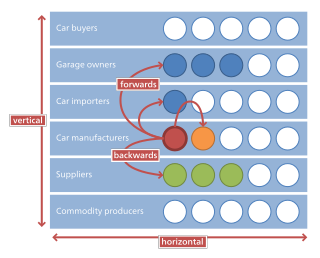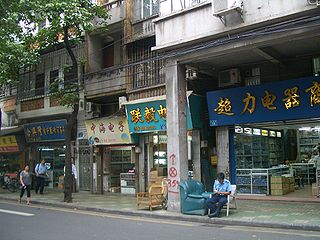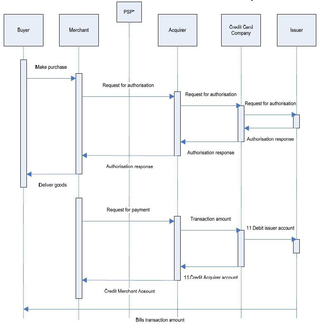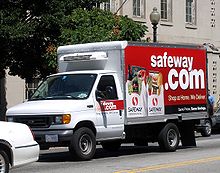E-commerce is the activity of electronically buying or selling of products on online services or over the Internet. E-commerce draws on technologies such as mobile commerce, electronic funds transfer, supply chain management, Internet marketing, online transaction processing, electronic data interchange (EDI), inventory management systems, and automated data collection systems. E-commerce is in turn driven by the technological advances of the semiconductor industry, and is the largest sector of the electronics industry.

Wholesaling or distributing is the sale of goods or merchandise to retailers; to industrial, commercial, institutional or other professional business users; or to other wholesalers and related subordinated services. In general, it is the sale of goods in bulk to anyone, either a person or an organization, other than the end consumer of that merchandise. Wholesaling is buying goods in bulk quantity, usually directly from the manufacture or source, at a discounted rate. The retailer then sells the goods to the end consumer at a higher price making a profit.

In microeconomics, management and international political economy, vertical integration is an arrangement in which the supply chain of a company is integrated and owned by that company. Usually each member of the supply chain produces a different product or (market-specific) service, and the products combine to satisfy a common need. It contrasts with horizontal integration, wherein a company produces several items that are related to one another. Vertical integration has also described management styles that bring large portions of the supply chain not only under a common ownership but also into one corporation.

Distribution is the process of making a product or service available for the consumer or business user who needs it, and a distributor is a business involved in the distribution stage of the value chain. Distribution can be done directly by the producer or service provider, or using indirect channels with distributors or intermediaries. Distribution is one of the four elements of the marketing mix: the other three elements being product, pricing, and promotion.

Name your own price (NYOP) is a pricing strategy under which buyers make a suggestion for a product’s price and the transaction occurs only if a seller accepts this quoted price. What happens is that the seller waits for a potential buyer's offer and can then either accept or reject that 'named price' that the user had offered. As the Internet is continuously being developed and online marketplaces are becoming increasingly more popular, consumers have more choices in terms of product pricing. Popularized by the reverse auction pioneer, Priceline.com, such pricing strategy asks consumers to 'name their own price' for various products and services like air tickets, hotels, rental cars, etc. The first bid a consumer places and the subsequent bid increments express the consumer's willingness or unwillingness to haggle. "The economic argument is that the number of bids a consumer submits to win a product in a NYOP auction is determined by the bidder’s intention to trade off higher expected savings from haggling against the associated frictional costs". NYOP retailers do not post a price for their products, and the final price of the transaction is only determined via a "reverse auction process", and these are key features that distinguish hotels and travel intermediaries from NYOP retailers. Similarly, LetYouKnow, Inc. pioneered the application of its own patented matching method within confines of the reverse auction process, whereby consumers name their own price for new vehicles.
Drop shipping is a form of retail business in which the seller accepts customer orders without keeping stock on hand. Instead, in a form of supply chain management, the seller transfers the orders and their shipment details either to the manufacturer, a wholesaler, another retailer, or a fulfillment house, which then ships the goods directly to the customer.

Business-to-business is a situation where one business makes a commercial transaction with another. This typically occurs when:

A car dealership, or car dealer, is a business that sells new or used cars, at the retail level, based on a dealership contract with an automaker or its sales subsidiary. Car dealerships also often sell spare parts and automotive maintenance services.
B2B e-commerce, short for business-to-business electronic commerce, is the sale of goods or services between businesses via an online sales portal. In general, it is used to improve the efficiency and effectiveness of a company's sales efforts. Instead of receiving orders using human assets manually – by telephone or e-mail – orders are received digitally, reducing overhead costs.
An online marketplace is a type of e-commerce website where product or service information is provided by multiple third parties. Online marketplaces are the primary type of multichannel ecommerce and can be a way to streamline the production process.
Channel conflict occurs when manufacturers (brands) disintermediate their channel partners, such as distributors, retailers, dealers, and sales representatives, by selling their products directly to consumers through general marketing methods and/or over the Internet.
A marketing channel consists of the people, organizations, and activities necessary to transfer the ownership of goods from the point of production to the point of consumption. It is the way products get to the end-user, the consumer; and is also known as a distribution channel. A marketing channel is a useful tool for management, and is crucial to creating an effective and well-planned marketing strategy.

In a supply chain, a vendor, supplier, provider or a seller, is an enterprise that contributes goods or services. Generally, a supply chain vendor manufactures inventory/stock items and sells them to the next link in the chain. Today, these terms refer to a supplier of any goods or service.
Direct-to-consumer (DTC) or business-to-consumer (B2C) is the business model of selling products directly to customers and thereby bypassing any third-party retailers, wholesalers, or any other middlemen. Direct-to-consumer sales are usually transacted online, but direct-to-consumer brands may also operate physical retail spaces as a complement to their main e-commerce platform in a clicks-and-mortar business model.

Electronic commerce, commonly known as e-commerce or eCommerce, or e-business consists of the buying and selling of products or services over electronic systems such as the Internet and other computer networks. The amount of trade conducted electronically has grown extraordinarily with widespread Internet usage. The use of commerce is conducted in this way, spurring and drawing on innovations in electronic funds transfer, supply chain management, Internet marketing, online transaction processing, electronic data interchange (EDI), inventory management systems, and automated data collection systems. Modern electronic commerce typically uses the World Wide Web at least at some point in the transaction's lifecycle, although it can encompass a wider range of technologies such as e-mail as well.
Wholesale fashion distribution refers to the global market of bulk clothing sales, in which producers, wholesalers and sellers are involved in a commercial, business-to-business process.
There are many types of e-commerce models', based on market segmentation, that can be used to conducted business online. The 6 types of business models that can be used in e-commerce include: Business-to-Consumer (B2C), Consumer-to-Business (C2B), Business-to-Business (B2B), Consumer-to-Consumer (C2C), Business-to-Administration (B2A), and Consumer-to-Administration
Pretail is a sub-category of e-commerce and online retail for introducing new products, services, and brands to market by pre-launching online, from creating an interest waitlist of signups before launch to collecting reservations or pre-orders in limited quantity before release, realization, or commercial availability. Pretail allows new product ideas/prototypes to be mass produced only when they have reached an initial threshold of buy-in from investors/consumers. Pretail includes pre-sale commerce, pre-order retailers, pre-launch marketing services, incubation marketplaces, crowdfunding communities, and demand chain management systems.
Re-intermediation in banking and finance can be defined as the movement of investment capital from non-bank investments, back into financial intermediaries. This is usually done in efforts to secure depository insurance on the capital, during times of high risk and volatility in market interest rates. Conceptually, reintermediation can be thought of as an answer to disintermediation, which is the movement of investment funds away from financial intermediaries into other investments. Disintermediation occurs naturally, as competition from different financial firms can allow for higher investment yield, which causes funds to flow away from depository institutions.
The disruptive effect of e-commerce on the global retail industry has been referred to as the Amazon Effect: the term refers to Amazon.com's dominant role in the e-commerce market place and its leading role in driving the disruptive impact on the retail market and its supply chain.










